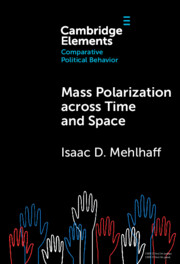Refine search
Actions for selected content:
38 results
Beyond political connections: a measurement model approach to estimating firm-level political influence in 41 countries
-
- Journal:
- Political Science Research and Methods , First View
- Published online by Cambridge University Press:
- 24 September 2025, pp. 1-20
-
- Article
-
- You have access
- Open access
- HTML
- Export citation
6 - Discrete and Continuous Variables
-
- Book:
- Probability and Statistics for Data Science
- Published online:
- 19 June 2025
- Print publication:
- 03 July 2025, pp 202-240
-
- Chapter
- Export citation

Mass Polarization across Time and Space
-
- Published online:
- 04 March 2025
- Print publication:
- 03 April 2025
-
- Element
- Export citation
The Polyserial Correlation Coefficient
-
- Journal:
- Psychometrika / Volume 47 / Issue 3 / September 1982
- Published online by Cambridge University Press:
- 01 January 2025, pp. 337-347
-
- Article
- Export citation
An Alternative Two Stage Least Squares (2SLS) Estimator for Latent Variable Equations
-
- Journal:
- Psychometrika / Volume 61 / Issue 1 / March 1996
- Published online by Cambridge University Press:
- 01 January 2025, pp. 109-121
-
- Article
- Export citation
Analyzing Sequential Categorical Data: Individual Variation in Markov Chains
-
- Journal:
- Psychometrika / Volume 55 / Issue 2 / June 1990
- Published online by Cambridge University Press:
- 01 January 2025, pp. 263-275
-
- Article
- Export citation
An Incomplete Data Approach to the Analysis of Covariance Structures
-
- Journal:
- Psychometrika / Volume 52 / Issue 4 / December 1987
- Published online by Cambridge University Press:
- 01 January 2025, pp. 539-554
-
- Article
- Export citation
An Instrumental Variable Estimator for Mixed Indicators: Analytic Derivatives and Alternative Parameterizations
-
- Journal:
- Psychometrika / Volume 85 / Issue 3 / September 2020
- Published online by Cambridge University Press:
- 01 January 2025, pp. 660-683
-
- Article
- Export citation
A Composite Likelihood Inference in Latent Variable Models for Ordinal Longitudinal Responses
-
- Journal:
- Psychometrika / Volume 77 / Issue 3 / July 2012
- Published online by Cambridge University Press:
- 01 January 2025, pp. 425-441
-
- Article
- Export citation
Two-Step Estimation of Models Between Latent Classes and External Variables
-
- Journal:
- Psychometrika / Volume 83 / Issue 4 / December 2018
- Published online by Cambridge University Press:
- 01 January 2025, pp. 871-892
-
- Article
- Export citation
Estimating Finite Mixtures of Ordinal Graphical Models
-
- Journal:
- Psychometrika / Volume 87 / Issue 1 / March 2022
- Published online by Cambridge University Press:
- 01 January 2025, pp. 83-106
-
- Article
- Export citation
High-Dimensional Maximum Marginal Likelihood Item Factor Analysis by Adaptive Quadrature
-
- Journal:
- Psychometrika / Volume 70 / Issue 3 / September 2005
- Published online by Cambridge University Press:
- 01 January 2025, pp. 533-555
-
- Article
- Export citation
A Polychoric Instrumental Variable (PIV) Estimator for Structural Equation Models with Categorical Variables
-
- Journal:
- Psychometrika / Volume 72 / Issue 3 / September 2007
- Published online by Cambridge University Press:
- 01 January 2025, pp. 309-326
-
- Article
- Export citation
Maximum Likelihood Estimation of Multivariate Polyserial and Polychoric Correlation Coefficients
-
- Journal:
- Psychometrika / Volume 52 / Issue 3 / September 1987
- Published online by Cambridge University Press:
- 01 January 2025, pp. 409-430
-
- Article
- Export citation
Model-Implied Instrumental Variable—Generalized Method of Moments (MIIV-GMM) Estimators for Latent Variable Models
-
- Journal:
- Psychometrika / Volume 79 / Issue 1 / January 2014
- Published online by Cambridge University Press:
- 01 January 2025, pp. 20-50
-
- Article
- Export citation
Bayesian Estimation of Circumplex Models Subject to Prior Theory Constraints and Scale-Usage Bias
-
- Journal:
- Psychometrika / Volume 71 / Issue 1 / March 2006
- Published online by Cambridge University Press:
- 01 January 2025, pp. 33-55
-
- Article
- Export citation
Regression Among Factor Scores
-
- Journal:
- Psychometrika / Volume 66 / Issue 4 / December 2001
- Published online by Cambridge University Press:
- 01 January 2025, pp. 563-575
-
- Article
- Export citation
Retrospective Questions and Correlations
-
- Journal:
- Psychometrika / Volume 52 / Issue 2 / March 1987
- Published online by Cambridge University Press:
- 01 January 2025, pp. 251-261
-
- Article
- Export citation
A Bayesian Modeling Approach for Generalized Semiparametric Structural Equation Models
-
- Journal:
- Psychometrika / Volume 78 / Issue 4 / October 2013
- Published online by Cambridge University Press:
- 01 January 2025, pp. 624-647
-
- Article
- Export citation
Generalized Multilevel Structural Equation Modeling
-
- Journal:
- Psychometrika / Volume 69 / Issue 2 / June 2004
- Published online by Cambridge University Press:
- 01 January 2025, pp. 167-190
-
- Article
- Export citation
